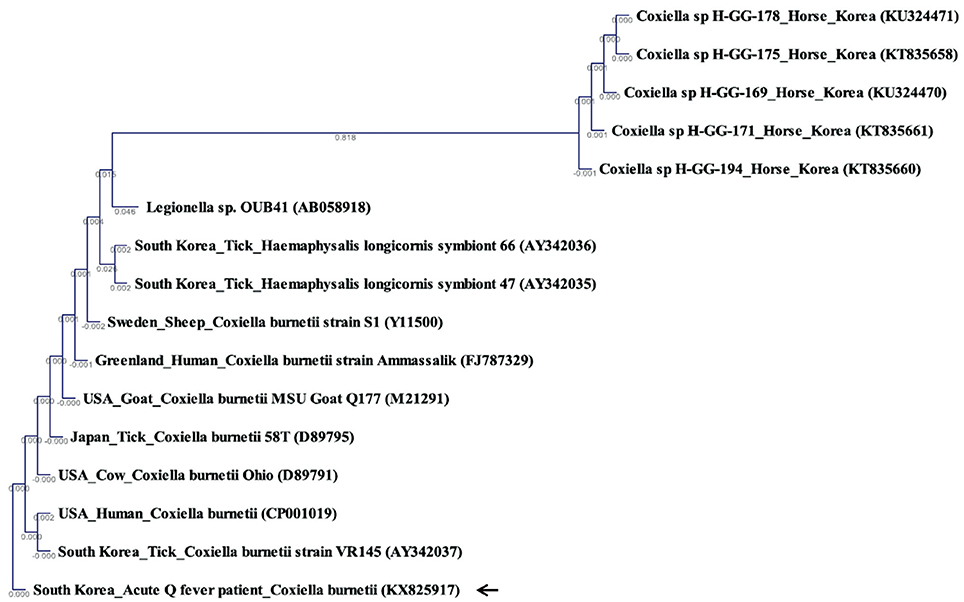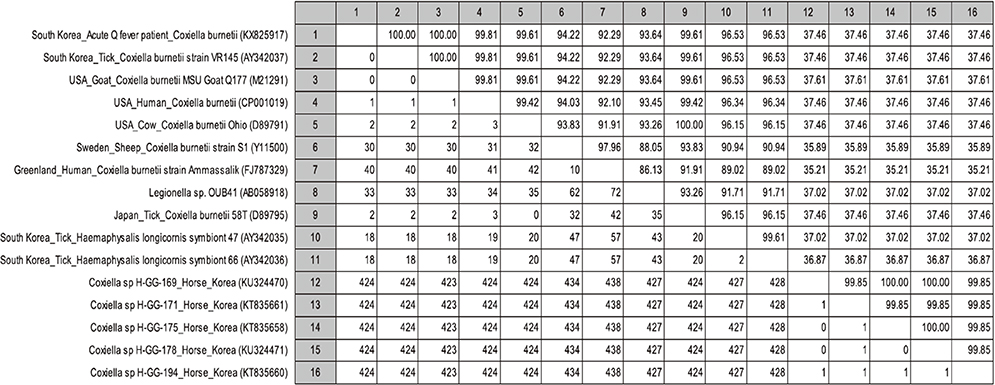J Korean Med Sci.
2017 Jun;32(6):1038-1041. 10.3346/jkms.2017.32.6.1038.
Clinical and Genetic Features of Coxiella burnetii in a Patient with an Acute Febrile Illness in Korea
- Affiliations
-
- 1Division of Zoonoses, Center for Immunology & Pathology, Korea National Institute of Health, Korea Centers for Disease Control & Prevention, Cheongju, Korea. hwangsd@korea.kr
- 2Division of Infectious Diseases, Department of Internal Medicine, Chungbuk National University College of Medicine, Cheongju, Korea.
- KMID: 2377736
- DOI: http://doi.org/10.3346/jkms.2017.32.6.1038
Abstract
- Although Q fever is an important zoonotic infection with a worldwide distribution, no human isolates of Coxiella burnetii have been identified in Korea. For the first time, we identified the nucleotide sequence of C. burnetii from a 32-year-old man with an acute febrile illness in Korea. Diagnosis of acute Q fever was confirmed by seroconversion using indirect immunofluorescence antibody assays. Phylogenetic analysis demonstrated high sequence similarity (99.6%-100%) with C. burnetii 16S rRNA sequences identified from the reservoir. These results are the first genetic analysis of C. burnetii in a human case of Q fever in Korea.
Keyword
MeSH Terms
Figure
Reference
-
1. Maurin M, Raoult D. Q fever. Clin Microbiol Rev. 1999; 12:518–553.2. Tissot-Dupont H, Raoult D. Q fever. Infect Dis Clin North Am. 2008; 22:505–514.3. Anderson A, Bijlmer H, Fournier PE, Graves S, Hartzell J, Kersh GJ, Limonard G, Marrie TJ, Massung RF, McQuiston JH, et al. Diagnosis and management of Q fever--United States, 2013: recommendations from CDC and the Q Fever Working Group. MMWR Recomm Rep. 2013; 62:1–30.4. Kim JY, Sung SR, Pyun JI, Her M, Kang SI, Lee HK, Jung SC. Seroprevalence of Q-fever in Korean native cattle. Korean J Vet Res. 2014; 54:147–150.5. Kim WJ, Hahn TW, Kim DY, Lee MG, Jung KS, Ogawa M, Kishimoto T, Lee ME, Lee SJ. Seroprevalence of Coxiella burnetii infection in dairy cattle and non-symptomatic people for routine health screening in Korea. J Korean Med Sci. 2006; 21:823–826.6. Korea Centers for Disease Control and Prevention. Disease web statistics system [Internet]. accessed on 1 October 2016. Available at http://is.cdc.go.kr/dstat/index.jsp.7. Duron O, Noël V, McCoy KD, Bonazzi M, Sidi-Boumedine K, Morel O, Vavre F, Zenner L, Jourdain E, Durand P, et al. The recent evolution of a maternally-inherited endosymbiont of ticks led to the emergence of the Q fever pathogen, Coxiella burnetii . PLoS Pathog. 2015; 11:e1004892.8. Seo MG, Lee SH, VanBik D, Ouh IO, Yun SH, Choi E, Park YS, Lee SE, Kim JW, Cho GJ, et al. Detection and genotyping of Coxiella burnetii and Coxiella-like bacteria in horses in South Korea. PLoS One. 2016; 11:e0156710.9. Lee M, Jang JJ, Kim YS, Lee SO, Choi SH, Kim SH, Yu E. Clinicopathologic features of Q fever patients with acute hepatitis. Korean J Pathol. 2012; 46:10–14.10. An SJ, Koo JW, Chung CY, Lee WY. A case of Q fever: person-to-person transmission. J Korean Pediatr Soc. 1998; 41:120–124.11. Park HS, Lee EG, Lee SY, Lyu CJ, Son YM, Kim DS, Kim KY, Lee WY. A case of Q fever: associated with pancytopenia, hepatitis, and myocarditis. Korean J Infect Dis. 1992; 24:45–54.12. Park JY, Lee WY, Cho SN, Park YS, Park KS, Youn HJ, Kang YB, Koh CM. Isolation and cultivation of a Coxiella burnetii strain from raw milk of dairy cows in Korea. J Korean Soc Microbiol. 1993; 28:285–293.13. Lee JH, Park HS, Jang WJ, Koh SE, Park TK, Kang SS, Kim BJ, Kook YH, Park KH, Lee SH. Identification of the Coxiella sp. detected from Haemaphysalis longicornis ticks in Korea. Microbiol Immunol. 2004; 48:125–130.14. Moon SY, Choi YS, Park MY, Lee JA, Chung MK, Chung HS, Jung DR, Song JH, Peck KR. Two cases of Q fever endocarditis. Infect Chemother. 2009; 41:199–204.15. Fournier PE, Raoult D. Comparison of PCR and serology assays for early diagnosis of acute Q fever. J Clin Microbiol. 2003; 41:5094–5098.16. Karagiannis I, Schimmer B, Van Lier A, Timen A, Schneeberger P, Van Rotterdam B, De Bruin A, Wijkmans C, Rietveld A, Van Duynhoven Y. Investigation of a Q fever outbreak in a rural area of The Netherlands. Epidemiol Infect. 2009; 137:1283–1294.17. Roest HI, Ruuls RC, Tilburg JJ, Nabuurs-Franssen MH, Klaassen CH, Vellema P, van den Brom R, Dercksen D, Wouda W, Spierenburg MA, et al. Molecular epidemiology of Coxiella burnetii from ruminants in Q fever outbreak, the Netherlands. Emerg Infect Dis. 2011; 17:668–675.18. Zhong J. Coxiella-like endosymbionts. In : Toman R, Heinzen RA, Samuel JE, Mege JL, editors. Coxiella Burnetii: Recent Advances and New Perspectives in Research of the Q Fever Bacterium. New York, NY: Springer;2012. p. 365–379.19. Kwak W, Chu H, Hwang S, Park JH, Hwang KJ, Gwack J, Choi YS, Youn SK, Park MY. Epidemiological characteristics of serologically confirmed Q fever cases in South Korea, 2006-2011. Osong Public Health Res Perspect. 2013; 4:34–38.20. Duron O, Sidi-Boumedine K, Rousset E, Moutailler S, Jourdain E. The importance of ticks in Q fever transmission: what has (and has not) been demonstrated? Trends Parasitol. 2015; 31:536–552.
- Full Text Links
- Actions
-
Cited
- CITED
-
- Close
- Share
- Similar articles
-
- The Association of Kawasaki Disease and Coxiella burnetii
- Clinical features of twelve coxiellemia pediatric patients in Korea
- Prevalence of antibodies to the coxiella burnetii phase II antigen among residents in korea
- Prevalence of antibodies to coxiella burnetii phase I antigen among Korean
- Prevalence of antibodies to the phase I antigen of coxiella burnetii , the Q fever agent, among residents in Korea



